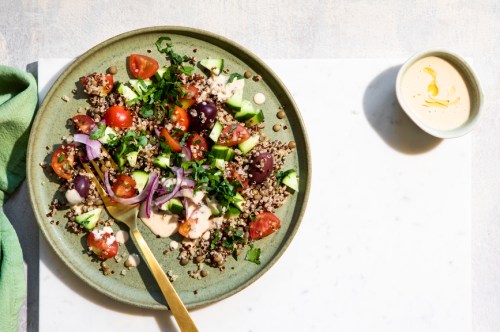Looking to promote heart health by boosting circulation? How about supporting your body’s ability to build protein and enhance athletic performance? If so, you’ll want to pay closer attention to how much L-arginine you’re getting in your diet.
Experts in This Article
If you’re unfamiliar with the many ways that L-arginine benefits your health, don’t sweat it. We tapped Emmaline Rasmussen, RDN, a registered dietitian and the founder of Sound Nutrition to cover some need-to-know info on this amino acid before rounding up the top food sources that contain it.
L-arginine benefits
L-arginine is an amino acid, which makes it a building block of protein. “It is a conditionally essential amino acid, meaning that our bodies produce it naturally, but do not necessarily produce as much as we need,” Rasmussen says. For instance, she says that people dealing with certain traumas such as major burns or injuries—or those in recovery from certain surgeries—may not be able to create an adequate supply required to reap its health benefits… which are what, exactly?
“L-arginine is great for circulation and certain cardiovascular conditions,” says Rasmussen, as it boasts the ability to dilate blood vessels by boosting nitric oxide levels in the blood. Due to this feature of L-arginine, she also points out that it “may be beneficial for those struggling with erectile dysfunction (ED) as well.” In a 2017 study published in the medical journal Andrology, researchers found that men who experienced ED had lower levels of both L-arginine and L-citrulline compared to participants without ED.
“L-arginine might also be beneficial for athletic performance and supporting healthy blood sugar levels,” Rasmussen adds.
The best food sources of L-arginine
Fortunately, it shouldn’t be too challenging to up your intake of L-arginine through whole food sources—especially if you’re getting enough protein in your diet already. “L-arginine can be found in most protein-rich foods,” Rasmussen says, before proceeding to list the best of the bunch below.
1. Meat and poultry
To start, Rasmussen says that meat and poultry are among the top food sources of L-arginine. With that said, she shares a few tips if you’re going to add more of these items—whether it’s ground beef, a juicy steak, or lean chicken breast—to your meal plan for the sake of wellness wins like muscle gains and improved circulation. “Consuming red meat in moderation is ideal for optimal cardiovascular and overall health, and be sure to balance your plate with vegetables and complex carbohydrates,” Rasmussen says.
2. Fatty fish
If you’re not aboard the fatty fish bandwagon just let, you’ll want to jump on since their benefits extend well beyond protein and L-arginine content. “When possible, I recommend choosing wild-caught or sustainably raised fatty fish that are rich in omega-3 fatty acids, which are anti-inflammatory and good for heart, eye, skin, and brain health,” Rasmussen shares. You’ll also want to keep tabs on low-mercury varieties.
Need some help deciding which ones to choose in the vast sea of options? “Sockeye salmon is my favorite in terms of nutrition and flavor, and steelhead trout is a good alternative as well,” Rasmussen continues. She also recommends browsing info from the Environmental Working Group (EWG), “a great resource for selecting omega-rich seafood that is low in mercury and [finding] which seafood options are more sustainable.”
3. Dairy
Before we pivot to plant-based sources of L-arginine, Rasmussen calls out dairy as another great animal source of this amino acid. “Yogurt and kefir are the healthiest choices for dairy foods as they contain gut-nurturing probiotics,” she says.
Prefer plant-based alternatives such as Rasmussen’s go-to’s like unsweetened almond milk and coconut milk yogurt? She says that they also contain L-arginine, but not as much as dairy.
4. Beans, legumes, and soy
If you follow a plant-based diet, rest assured that staples such as beans, legumes, and soy all pack L-arginine. Of this bunch, Rasmussen particularly recommends lentils (which are also a good source of iron, an essential mineral for circulation) and lupini beans. Rasmussen also loves organic soy beans, like edamame, as well as tofu.
5. Whole grains
Finally, Rasmussen says that whole grains aren’t only a valid source of L-arginine, but that they “provide a host of vitamins, minerals, fiber, and small amounts of protein as well.” Whether or not you follow a plant-based diet, whole grains are *amazing* for your health—see their inclusion across Blue Zones—and they offer “a slow sustained energy source, particularly when paired with healthy fats, leafy greens, and [additional] protein,” she says.
Better yet, you have tons of options to choose from in the grain department. Rasmussen calls out amaranth, spelt, rye, and wild or brown rice as her top picks (but advises skipping on spelt and rye if you’re gluten-free). She also recommends pseudo-grain superfoods such as quinoa and buckwheat. “They are nutritionally similar to grains and are interchangeable from a culinary perspective, but are technically not grains themselves,” Rasmussen says.
Sign Up for Our Daily Newsletter
Get all the latest in wellness, trends, food, fitness, beauty, and more delivered right to your inbox.
Got it, you've been added to our email list.










